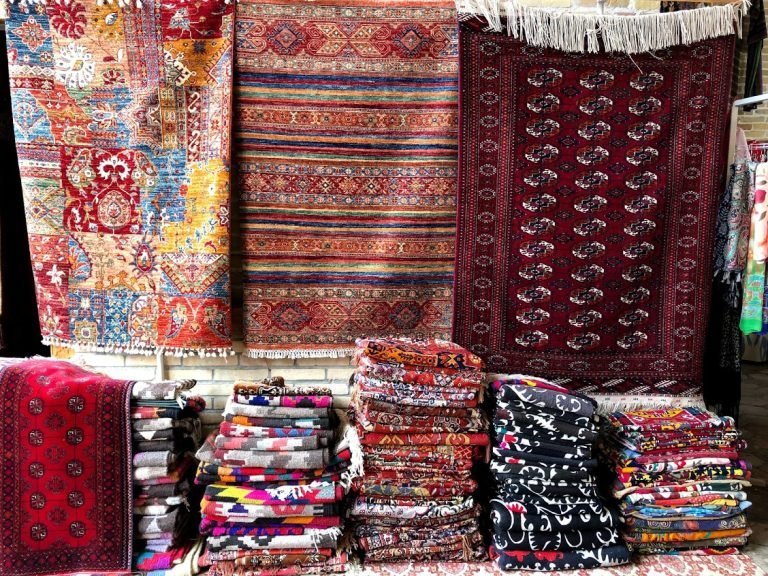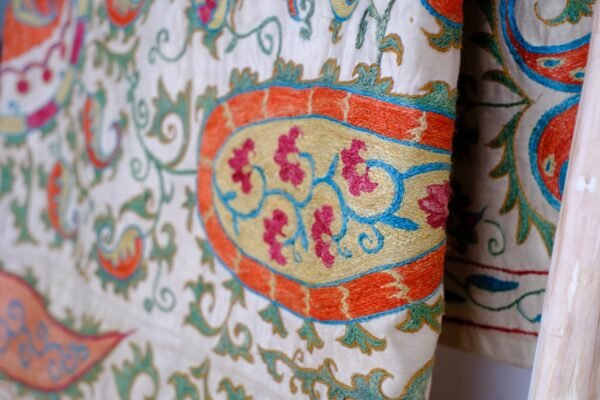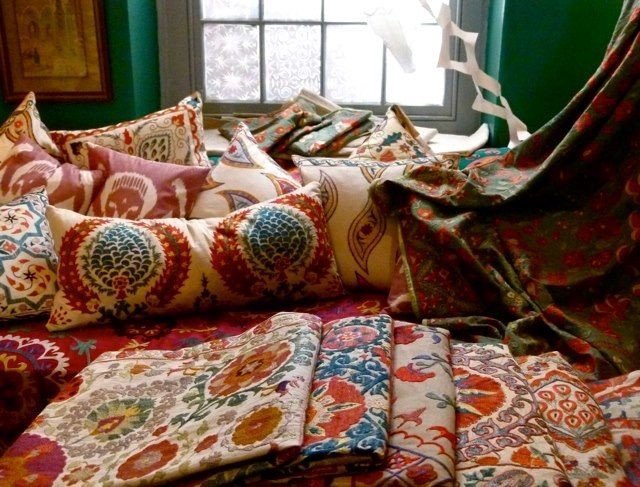Join Our Newsletter
Subscribe to the Alesouk mailing list to receive updates on new arrivals, special offers and other discount information.
*By completing this form you're signing up to receive our emails and can unsubscribe at any time.
The world of textiles is as diverse as it is captivating, with each region of the world imparting its unique touch to the fabric of life. Among these, the art of Suzani embroidery from Central Asia holds a place of particular significance. Suzani, a word derived from the Persian سوزن, Suzan, meaning ‘needle’, is an embroidered and decorative tribal textile that has been a part of Central Asian heritage for centuries.
Primarily produced in the countries of Tajikistan, Uzbekistan, and Kazakhstan, Suzani represents a fascinating blend of regional artistry, cultural narratives, and meticulous craftsmanship. In this comprehensive guide, we delve into the intricate world of Suzani, exploring its various types, unique aesthetics, traditional uses, symbolic motifs, and the rich history it embodies.

At its core, Suzani is a testament to the meticulous skill of the artisans who craft it. These textiles typically employ a cotton or sometimes silk fabric base, which is then adorned with intricate designs using silk or cotton thread.
The primary stitches used in Suzani embroidery are chain, satin, and buttonhole stitches. These create a rich texture and a vibrant display of motifs that are characteristic of Suzani. In addition to these, there is an extensive use of couching. This technique involves laying decorative thread on the fabric in a raised line, which is then stitched in place using a second thread. This adds an element of depth and sophistication to the finished piece.
Another interesting aspect of Suzani production is that they are often made in two or more pieces. These individual segments are embroidered separately and then meticulously stitched together to form the final textile. This method not only facilitates the intricate embroidery process but also adds to the distinct charm of Suzani artworks.
The world of Suzani is as varied as the regions that produce it. Each area imparts its unique flair to the craft, resulting in a variety of Suzani types. Here are some of the major types that you may encounter:
Bukhara Suzani: Known for its pomegranate designs and vibrant colors.
Khodjent Suzani (Khodjent, Tajikistan): Distinct for its intricate patterns and exquisite craftsmanship.
Lakai Suzani: Recognizable by its bold designs and striking color combinations.
Nurata Suzani: Originating from the town of Nurata in Uzbekistan, it is celebrated for its delicate embroidery and refined aesthetics.
Pskent Suzani: Renowned for its unique motifs and detailed needlework.
Samarkand Suzani: Appreciated for its complex designs and the narratives they portray.
Shakhrisabz Suzani: Distinguished by its traditional motifs and rich colors.
Tashkent Suzani: Noted for its modern interpretations of traditional designs.
Ura Tube Suzani (Istaravshan, Tajikistan): Famed for its cultural representation and exceptional artistry.
Suzani is not just about skilled embroidery; it is also a celebration of nature and life. The motifs commonly found in Suzani designs reflect this. Sun and moon disks symbolize the cosmic elements, while flowers like tulips, carnations, and irises represent the beauty of flora. Leaves and vines signify growth and vitality Fruits, especially pomegranates, are also common, symbolizing fertility and abundance. Occasional depictions of fish and birds add to the diversity of the motifs, each carrying their symbolic connotations.
The color palette of Suzani is usually vibrant and lively, reflecting the spirited culture of Central Asia. The designs are often symmetrical, creating a sense of harmony and balance in the overall aesthetics. Each Suzani piece, whether a Bukhara Suzani with its iconic pomegranate design or a Khodjent Suzani with its intricate patterns, is a visual delight, exuding an undeniable charm and elegance.

In the cultural context of Central Asia, Suzani has traditionally played a significant role. These beautifully embroidered textiles were often crafted by brides as part of their dowry and presented to the groom on the wedding day. This not only showcased the bride’s devotion and skill but also added a personal touch to the union.
Over the years, Suzanis have found their way into various aspects of everyday life. Their rich colors and intricate designs have made them popular as wall hangings, bedspreads, furniture covers, and even ceremonial robes. Each Suzani carries a story, as unique and rich as the designs that grace its surface. Some were perhaps bartered in lean times, adding another layer to their historical narrative.
The history of Suzani is as intricate as the motifs that adorn it. While the oldest surviving Suzanis date back to the late 18th and early 19th centuries, it is believed that the tradition predates this period. Ruy Gonzáles de Clavijo, a Castilian ambassador to the court of Timur (Tamerlane) in the early 15th century, left detailed descriptions of embroideries that were likely precursors to the Suzani we know today.
This rich history of Suzani, coupled with its vibrant aesthetics and cultural significance, makes it more than just a textile. It is a living testament to the artistic spirit of Central Asia, a legacy passed down through generations, and a craft that continues to evolve while staying true to its roots.
In essence, Suzani is more than an embroidered textile; it’s a vibrant celebration of Central Asian culture, a canvas of storytelling, and a testament to the region’s artistic prowess. Whether it adorns the walls of a home or forms part of a bride’s dowry, each Suzani piece carries within it a piece of history and a story waiting to be told.
Creating a Suzani is a journey that requires patience, skill, and a deep understanding of the cultural motifs that make this art form unique. The process begins with the selection of a suitable base fabric, usually cotton or silk, onto which the design will be embroidered.
The design, often inspired by nature and traditional symbols, is then sketched onto the fabric. This step requires not only an artistic vision but also a deep understanding of Suzani’s traditional motifs and their meanings. The design must resonate with the cultural narratives of Central Asia and the aesthetic expectations of Suzani art.
Once the design is sketched, the painstaking task of embroidery begins. Using silk or cotton threads, the artisan embroiders the design onto the fabric, one stitch at a time. This stage can take several weeks or even months, depending on the complexity of the design and the size of the Suzani. The primary stitches used are chain, satin, and buttonhole stitches, each adding a unique texture to the overall design. Additionally, the technique of couching is used to create raised lines, adding depth to the design.
Often, a Suzani is made in two or more pieces, especially for larger textiles. Each piece is worked on separately and then stitched together to form the final Suzani. This method not only eases the intricate process of embroidery but also adds a unique touch to the finished textile, as slight variations in the patterns of each segment make each Suzani a one-of-a-kind piece.
In recent years, the world has seen a resurgence of interest in traditional crafts, and Suzani is no exception. Its vibrant colors, intricate designs, and unique cultural narratives have captivated a global audience. This has not only created a renewed demand for traditional Suzani textiles but also inspired modern interpretations of this ancient art form.
In the realm of interior design, for instance, Suzani has found a place in contemporary homes, adding a touch of exotic charm and vibrant color to modern interiors. Suzani-inspired designs grace everything from cushions and curtains to upholstery and wall art. These pieces often combine traditional Suzani motifs with contemporary design elements, creating a unique fusion that appeals to modern aesthetics while keeping the spirit of Suzani alive.
In fashion, too, Suzani has made its mark. Designers have incorporated Suzani-inspired embroidery in their collections, using its vibrant designs and intricate motifs to create standout pieces. Whether it’s a statement jacket adorned with Suzani motifs or a handbag with Suzani-inspired embroidery, these pieces blend tradition with modern style, allowing wearers to carry a piece of Central Asian heritage with them.
The survival and revival of Suzani in the modern world owe much to the dedicated artisans who have kept this craft alive through generations, often against the odds. These skilled craftsmen and women have passed down their knowledge and skills, ensuring that the art of Suzani continues to flourish.
Collectors and enthusiasts also play a crucial role in preserving the Suzani heritage. By collecting, studying, and showcasing Suzani textiles, they contribute to the appreciation and understanding of this art form. They also support the artisan communities by providing a market for their craft, encouraging the continuation of this ancient tradition.

While Suzani is undoubtedly a visually striking art form, its significance extends far beyond aesthetics. Every Suzani is imbued with a wealth of cultural and symbolic meanings, making it a rich repository of Central Asian traditions and values.
The motifs found in Suzani designs are deeply symbolic, drawn from a well of shared cultural narratives. For instance, the sun and moon disks often found in Suzani designs are believed to symbolize life and fertility, while flowers and fruits like pomegranates represent abundance and prosperity. The fish and birds occasionally featured in Suzani designs also have their own symbolic meanings, adding further layers of depth to these vibrant textiles.
Moreover, the very process of creating a Suzani is a cultural ritual in itself. Traditionally, Suzanis were made by Central Asian brides as part of their dowry and presented to the groom on their wedding day. This practice was not only a demonstration of the bride’s artistic skill and diligence but also a symbol of her devotion and commitment to her future family. Thus, every stitch in a Suzani is a testament to a woman’s hopes and dreams for her future, adding an emotional depth to these textiles that transcends their physical beauty.
While all Suzanis share certain standard features, such as the use of embroidery and traditional motifs, there is a surprising diversity in styles and techniques across different regions. This diversity is a testament to the adaptability and creativity of Central Asian artisans, who have continued to innovate and evolve their craft while preserving its essential spirit.
For instance, the Bukhara Suzani is known for its bold, graphic designs, often featuring large, stylized flowers and fruits. The Khodjent Suzani, on the other hand, is renowned for its intricate, finely-detailed patterns, which often cover the entire surface of the textile. The Nurata Suzani, made in the town of Nurata in Uzbekistan, is characterized by its distinctive color palette, with a particular emphasis on warm, earthy tones.
These regional variations not only add to the richness and diversity of the Suzani tradition but also make each Suzani a unique piece of art, reflecting the distinct cultural identity and artistic sensibility of its place of origin.
In the face of a rapidly changing world, Suzani stands as a vibrant symbol of continuity and resilience. It is a living heritage, a testament to the enduring power of traditional crafts and the human spirit that sustains them.
Whether we are admiring a Suzani in a museum, using it to enhance our home decor, or wearing a Suzani-inspired fashion piece, we are participating in a centuries-old tradition, a narrative that connects us to a rich cultural past while constantly evolving and adapting to the present.
Through their beauty, complexity, and cultural resonance, Suzanis continue to inspire, captivate, and spark dialogues, reminding us of the power of art to connect us across cultures and time. As we look forward to the future of Suzani, we celebrate not only a craft but also the extraordinary human creativity and cultural richness it embodies.
Suzani is more than a beautiful textile; it’s a vibrant tapestry of history, culture, and artistry that has withstood the test of time. As we appreciate the beauty of a Suzani piece, we also appreciate a story – a story of tradition, craftsmanship, and a rich cultural heritage that continues to inspire and captivate to this day.

Subscribe to the Alesouk mailing list to receive updates on new arrivals, special offers and other discount information.
*By completing this form you're signing up to receive our emails and can unsubscribe at any time.

Lorem ipsum dolor sit amet, consectetuer adipiscing elit, sed diam nonummy nibh euismod tincidunt ut laoreet dolore magna aliquam erat volutpat.
Shop Suzanies Now